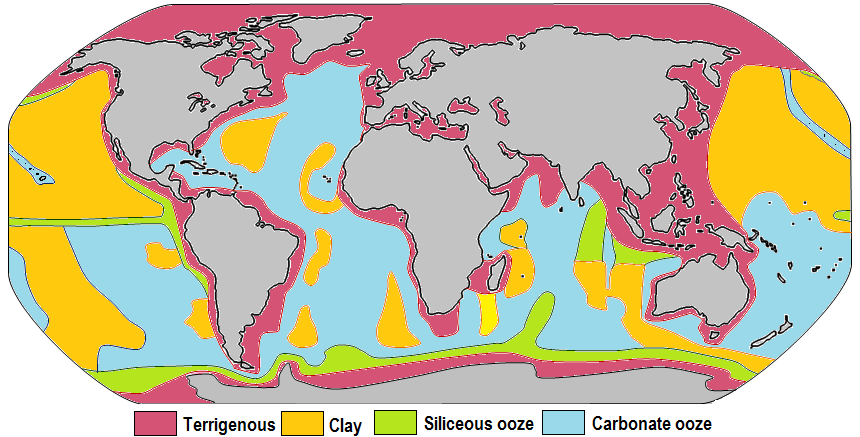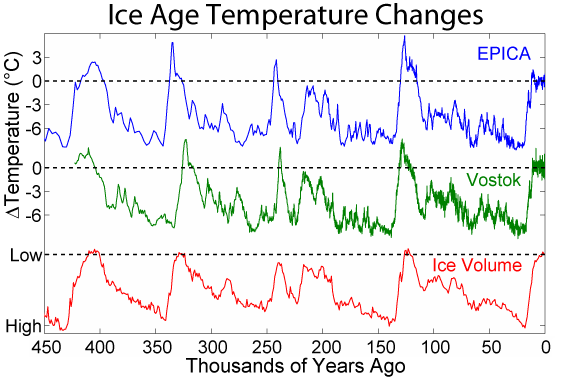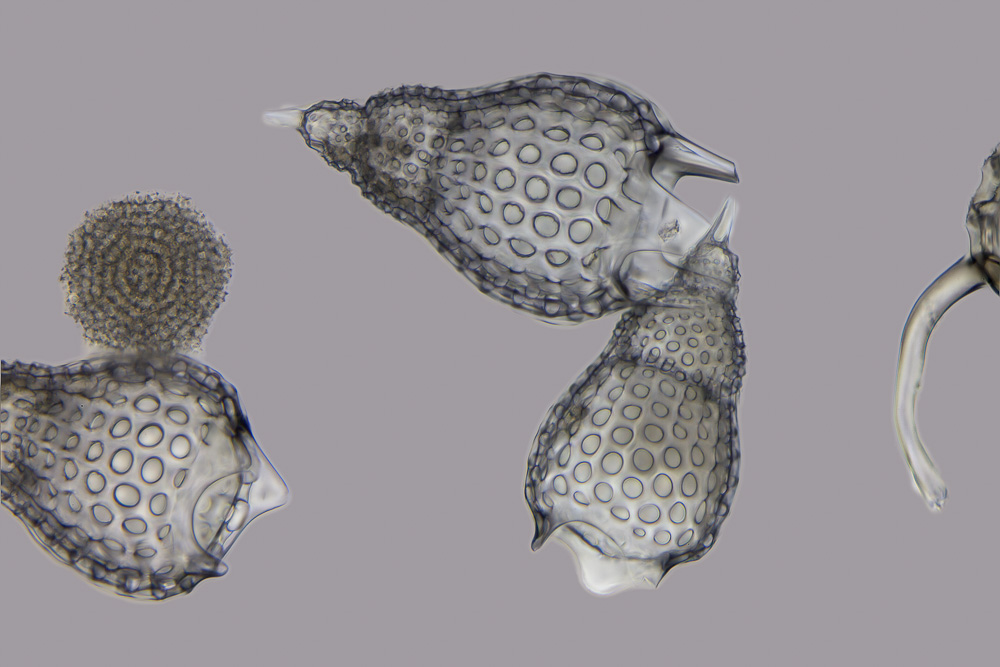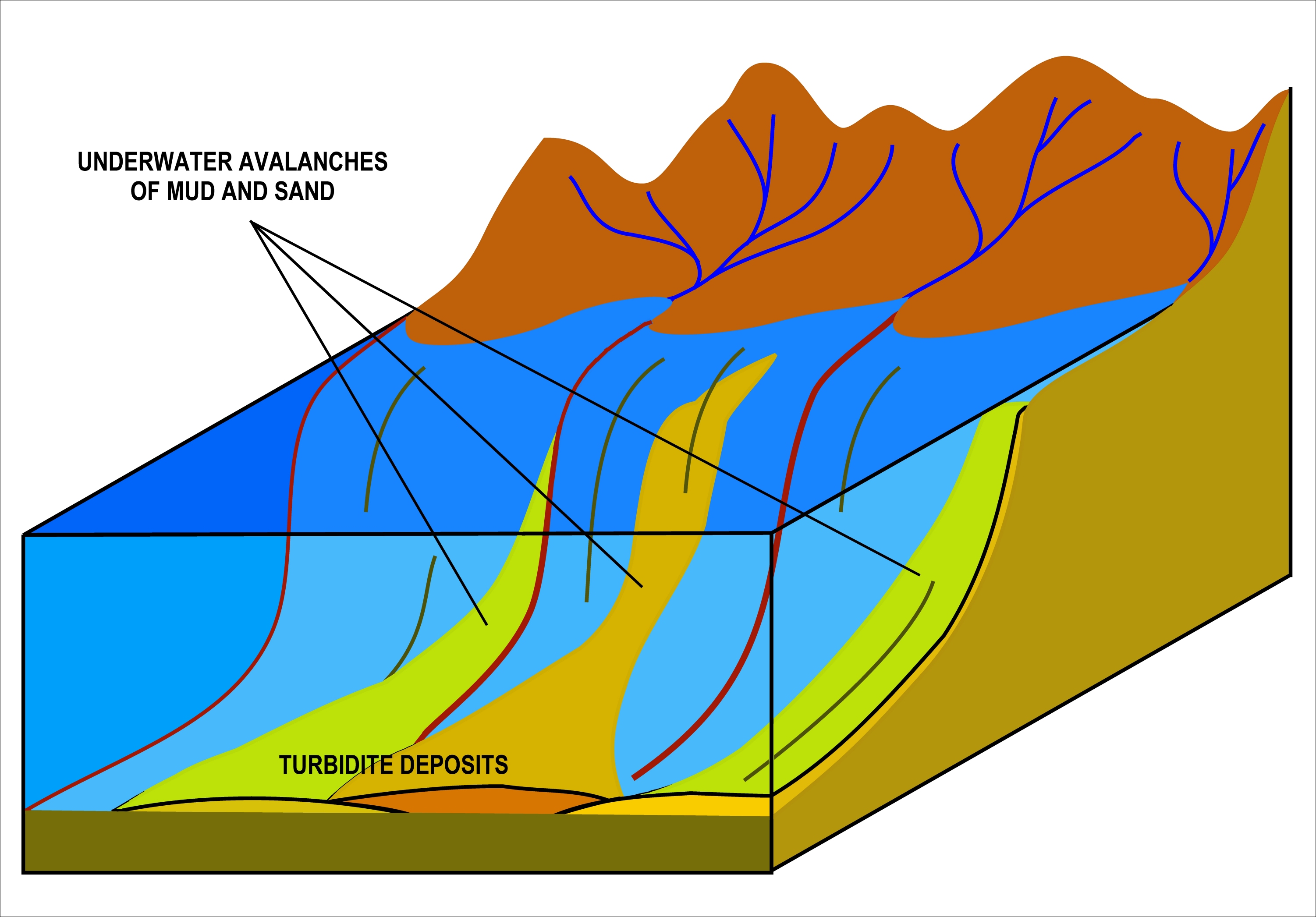|
Hemipelagic Sediment
Hemipelagic sediment, or hemipelagite, is a type of marine sediment that consists of clay and silt-sized grains that are terrigenous and some biogenic material derived from the landmass nearest the deposits or from organisms living in the water. Hemipelagic sediments are deposited on continental shelves and continental rises, and differ from pelagic sediment compositionally. Pelagic sediment is composed of primarily biogenic material from organisms living in the water column or on the seafloor and contains little to no terrigenous material. Terrigenous material includes minerals from the lithosphere like feldspar or quartz. Volcanism on land, wind blown sediments as well as particulates discharged from rivers can contribute to Hemipelagic deposits. These deposits can be used to qualify climatic changes and identify changes in sediment provenances. Deposition Hemipelagic sediment dispersal is mainly controlled by fluvial discharge. Dispersal rate is influenced by sea-level variatio ... [...More Info...] [...Related Items...] OR: [Wikipedia] [Google] [Baidu] |
Marine Sediment
Marine sediment, or ocean sediment, or seafloor sediment, are deposits of insoluble particles that have accumulated on the seafloor. These particles have their origins in soil and rocks and have been transported from the land to the sea, mainly by rivers but also by dust carried by wind and by the flow of glaciers into the sea. Additional deposits come from marine organisms and chemical precipitation in seawater, as well as from underwater volcanoes and meteorite debris. Except within a few kilometres of a mid-ocean ridge, where the volcanic rock is still relatively young, most parts of the seafloor are covered in sediment. This material comes from several different sources and is highly variable in composition. Seafloor sediment can range in thickness from a few millimetres to several tens of kilometres. Near the surface seafloor sediment remains unconsolidated, but at depths of hundreds to thousands of metres the sediment becomes lithified (turned to rock). Rates of sediment ... [...More Info...] [...Related Items...] OR: [Wikipedia] [Google] [Baidu] |
Interglacial
An interglacial period (or alternatively interglacial, interglaciation) is a geological interval of warmer global average temperature lasting thousands of years that separates consecutive glacial periods within an ice age. The current Holocene interglacial began at the end of the Pleistocene, about 11,700 years ago. Pleistocene During the 2.5 million years of the Pleistocene, numerous glacials, or significant advances of continental ice sheets, in North America and Europe, occurred at intervals of approximately 40,000 to 100,000 years. The long glacial periods were separated by more temperate and shorter interglacials. During interglacials, such as the present one, the climate warms and the tundra recedes polewards following the ice sheets. Forests return to areas that once supported tundra vegetation. Interglacials are identified on land or in shallow epicontinental seas by their paleontology. Floral and faunal remains of species pointing to temperate climate and indicating a s ... [...More Info...] [...Related Items...] OR: [Wikipedia] [Google] [Baidu] |
Detritus
In biology, detritus () is dead particulate organic material, as distinguished from dissolved organic material. Detritus typically includes the bodies or fragments of bodies of dead organisms, and fecal material. Detritus typically hosts communities of microorganisms that colonize and decompose (i.e. remineralize) it. In terrestrial ecosystems it is present as leaf litter and other organic matter that is intermixed with soil, which is denominated " soil organic matter". The detritus of aquatic ecosystems is organic material that is suspended in the water and accumulates in depositions on the floor of the body of water; when this floor is a seabed, such a deposition is denominated "marine snow". Theory The corpses of dead plants or animals, material derived from animal tissues (e.g. molted skin), and fecal matter gradually lose their form due to physical processes and the action of decomposers, including grazers, bacteria, and fungi. Decomposition, the process by which or ... [...More Info...] [...Related Items...] OR: [Wikipedia] [Google] [Baidu] |
Tuffaceous
Tuff is a type of rock made of volcanic ash ejected from a vent during a volcanic eruption. Following ejection and deposition, the ash is lithified into a solid rock. Rock that contains greater than 75% ash is considered tuff, while rock containing 25% to 75% ash is described as tuffaceous (for example, ''tuffaceous sandstone''). Tuff composed of sandy volcanic material can be referred to as volcanic sandstone. Tuff is a relatively soft rock, so it has been used for construction since ancient times. Because it is common in Italy, the Romans used it often for construction. The Rapa Nui people used it to make most of the ''moai'' statues on Easter Island. Tuff can be classified as either igneous or sedimentary rock. It is usually studied in the context of igneous petrology, although it is sometimes described using sedimentological terms. Tuff is often erroneously called tufa in guidebooks and in television programmes. Volcanic ash The material that is expelled in a volcan ... [...More Info...] [...Related Items...] OR: [Wikipedia] [Google] [Baidu] |
Chert
Chert () is a hard, fine-grained sedimentary rock composed of microcrystalline or cryptocrystalline quartz, the mineral form of silicon dioxide (SiO2). Chert is characteristically of biological origin, but may also occur inorganically as a precipitation (chemistry), chemical precipitate or a diagenesis, diagenetic replacement, as in petrified wood. Chert is typically composed of the petrified remains of siliceous ooze, the biogenic sediment that covers large areas of the deep ocean floor, and which contains the silicon skeletal remains of diatoms, Dictyochales, silicoflagellates, and radiolarians. Precambrian cherts are notable for the presence of fossil cyanobacteria. In addition to Micropaleontology, microfossils, chert occasionally contains macrofossils. However, some chert is devoid of any fossils. Chert varies greatly in color (from white to black), but most often manifests as gray, brown, grayish brown and light green to rusty redW.L. Roberts, T.J. Campbell, G.R. Rapp Jr. ... [...More Info...] [...Related Items...] OR: [Wikipedia] [Google] [Baidu] |
Argillite
:''"Argillite" may also refer to Argillite, Kentucky.'' Argillite () is a fine-grained sedimentary rock composed predominantly of indurated clay particles. Argillaceous rocks are basically lithified muds and oozes. They contain variable amounts of silt-sized particles. The argillites grade into shale when the fissile layering typical of shale is developed. Another name for poorly lithified argillites is ''mudstone''. These rocks, although variable in composition, are typically high in aluminium and silica with variable alkali and alkaline earth cations. The term ''pelitic'' or ''pelite'' is often applied to these sediments and rocks. Metamorphism of argillites produces slate, phyllite, and pelitic schist. Belt Supergroup The Belt Supergroup, an assemblage of rocks of late Precambrian (Mesoproterozoic) age, includes thick sequences of argillite, as well as other metamorphosed or semi-metamorphosed mudstones.Schieber, J. 1990. Significance of styles of epicontinental shale sedime ... [...More Info...] [...Related Items...] OR: [Wikipedia] [Google] [Baidu] |
Sedimentary Rock
Sedimentary rocks are types of rock that are formed by the accumulation or deposition of mineral or organic particles at Earth's surface, followed by cementation. Sedimentation is the collective name for processes that cause these particles to settle in place. The particles that form a sedimentary rock are called sediment, and may be composed of geological detritus (minerals) or biological detritus (organic matter). The geological detritus originated from weathering and erosion of existing rocks, or from the solidification of molten lava blobs erupted by volcanoes. The geological detritus is transported to the place of deposition by water, wind, ice or mass movement, which are called agents of denudation. Biological detritus was formed by bodies and parts (mainly shells) of dead aquatic organisms, as well as their fecal mass, suspended in water and slowly piling up on the floor of water bodies (marine snow). Sedimentation may also occur as dissolved minerals precipitate from ... [...More Info...] [...Related Items...] OR: [Wikipedia] [Google] [Baidu] |
Diatoms
A diatom (New Latin, Neo-Latin ''diatoma''), "a cutting through, a severance", from el, διάτομος, diátomos, "cut in half, divided equally" from el, διατέμνω, diatémno, "to cut in twain". is any member of a large group comprising several Genus, genera of algae, specifically microalgae, found in the oceans, waterways and soils of the world. Living diatoms make up a significant portion of the Earth's Biomass (ecology), biomass: they generate about 20 to 50 percent of the oxygen produced on the planet each year, take in over 6.7 billion metric tons of silicon each year from the waters in which they live, and constitute nearly half of the organic material found in the oceans. The Protist shell, shells of dead diatoms can reach as much as a half-mile (800 m) deep on the ocean floor, and the entire Amazon basin is fertilized annually by 27 million tons of diatom shell dust transported by transatlantic winds from the African Sahara, much of it from the Bodélé Dep ... [...More Info...] [...Related Items...] OR: [Wikipedia] [Google] [Baidu] |
Radiolarians
The Radiolaria, also called Radiozoa, are protozoa of diameter 0.1–0.2 mm that produce intricate mineral skeletons, typically with a central capsule dividing the cell into the inner and outer portions of endoplasm and ectoplasm. The elaborate mineral skeleton is usually made of silica. They are found as zooplankton throughout the global ocean. As zooplankton, radiolarians are primarily heterotrophic, but many have photosynthetic endosymbionts and are, therefore, considered mixotrophs. The skeletal remains of some types of radiolarians make up a large part of the cover of the ocean floor as siliceous ooze. Due to their rapid change as species and intricate skeletons, radiolarians represent an important diagnostic fossil found from the Cambrian onwards. Description Radiolarians have many needle-like pseudopods supported by bundles of microtubules, which aid in the radiolarian's buoyancy. The cell nucleus and most other organelles are in the endoplasm, while the ectoplasm is ... [...More Info...] [...Related Items...] OR: [Wikipedia] [Google] [Baidu] |
Turbidite
A turbidite is the geologic deposit of a turbidity current, which is a type of amalgamation of fluidal and sediment gravity flow responsible for distributing vast amounts of clastic sediment into the deep ocean. Sequencing Turbidites were first properly described by Arnold H. Bouma (1962), who studied deepwater sediments and recognized particular "fining-up intervals" within deep water, fine-grained shales, which were anomalous because they started at pebble conglomerates and terminated in shales. This was anomalous because within the deep ocean it had historically been assumed that there was no mechanism by which tractional flow could carry and deposit coarse-grained sediments into the abyssal depths. Bouma cycles begin with an erosional contact of a coarse lower bed of pebble to granule conglomerate in a sandy matrix, and grade up through coarse then medium plane parallel sandstone; through cross-bedded sandstone; rippled cross-bedded sand/silty sand, and finally lami ... [...More Info...] [...Related Items...] OR: [Wikipedia] [Google] [Baidu] |
Turbidity Currents
A turbidity current is most typically an underwater current of usually rapidly moving, sediment-laden water moving down a slope; although current research (2018) indicates that water-saturated sediment may be the primary actor in the process. Turbidity currents can also occur in other fluids besides water. Researchers from the Monterey Bay Aquarium Research Institute found that a layer of water-saturated sediment moved rapidly over the seafloor and mobilized the upper few meters of the preexisting seafloor. Plumes of sediment-laden water were observed during turbidity current events but they believe that these were secondary to the pulse of the seafloor sediment moving during the events. The belief of the researchers is that the water flow is the tail-end of the process that starts at the seafloor. In the most typical case of oceanic turbidity currents, sediment laden waters situated over sloping ground will flow down-hill because they have a higher density than the adjacent ... [...More Info...] [...Related Items...] OR: [Wikipedia] [Google] [Baidu] |
Glacial
A glacial period (alternatively glacial or glaciation) is an interval of time (thousands of years) within an ice age that is marked by colder temperatures and glacier advances. Interglacials, on the other hand, are periods of warmer climate between glacial periods. The Last Glacial Period ended about 15,000 years ago. The Holocene is the current interglacial. A time with no glaciers on Earth is considered a greenhouse climate state. Quaternary Period Within the Quaternary, which started about 2.6 million years before present, there have been a number of glacials and interglacials. At least eight glacial cycles have occurred in the last 740,000 years alone. Penultimate Glacial Period The Penultimate Glacial Period (PGP) is the glacial period that occurred before the Last Glacial Period. It began about 194,000 years ago and ended 135,000 years ago, with the beginning of the Eemian interglacial. Last Glacial Period The last glacial period was the most recent glacial period ... [...More Info...] [...Related Items...] OR: [Wikipedia] [Google] [Baidu] |








